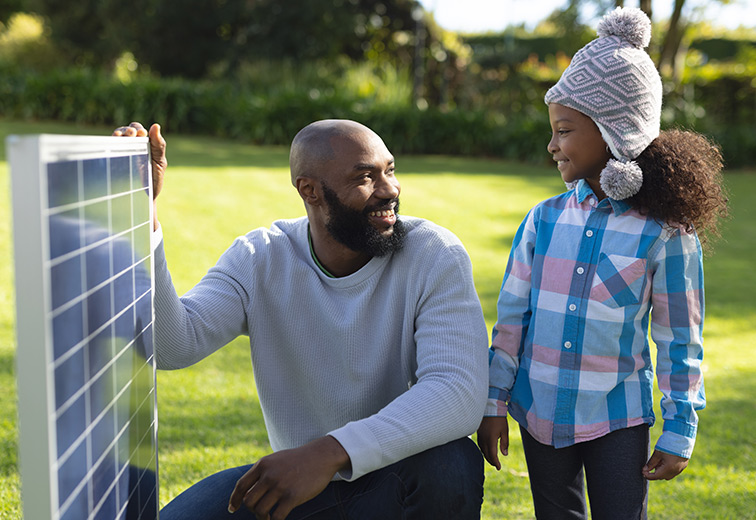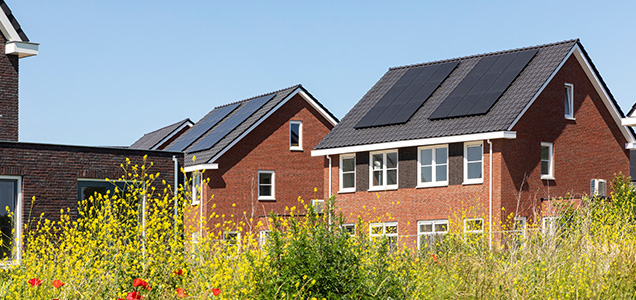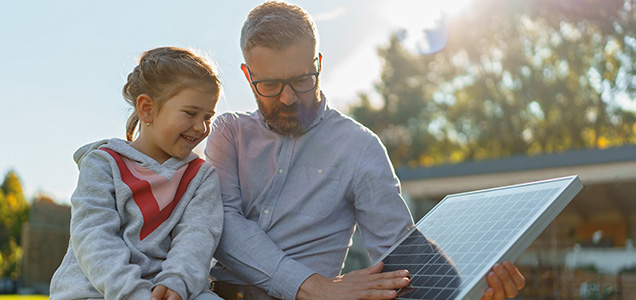Microgeneration is here
Electric Ireland is support customers on their low-carbon journey with a current Microgen export rate of 19.5c per kWh.
Electric Ireland is support customers on their low-carbon journey with a current Microgen export rate of 19.5c per kWh.

Microgeneration is the generation of green electricity from renewable technologies, such as solar panels, micro-wind, micro-hydro and micro-renewable combined heat and power (CHP).
The Government Microgeneration Support Scheme is now available so that those with a registered microgeneration device can sell any excess electricity back to Ireland’s electricity grid. This will help households reduce their carbon footprint and save money.

The Government Microgeneration Support Scheme allows households with a registered microgeneration device to sell any excess electricity back to Ireland’s electricity grid. This payment is called a Clean Export Guarantee (CEG).
Electric Ireland customers who own a micro-generator such as solar PV, micro-wind, micro-hydro, or renewable micro-CHP are eligible for this scheme. You must have an export grid connection, which is typically organised by the installer on installation or can be organised through ESB Networks.

Most Electric Ireland microgenerators have solar PV installed on their roof. Your solar PV installer would have registered an NC6 form on your behalf to ESB Networks. This form provides us with the information we need to set you up.
Learn more about solar
Electric Ireland customers can avail of up to €2,100 from an SEAI grant towards the cost of installing solar PV in your home.
Learn more about grants
Microgeneration is here and Electric Ireland is supporting customers on their low-carbon journey. Architect and environmentalist Duncan Stewart speaks to Electric Ireland about the small changes we can all make that will have a big impact.
Learn more
Aoife Gallagher is Electric Ireland’s Microgeneration Product Manager, and as an energy engineer is best-placed to answer some of your frequently asked questions around microgeneration.
Learn more
Electric Ireland’s current Microgen Export rate is 19.5c per kWh. This rate is variable and subject to change. We estimate that customer export payments will range between €50-€300 per year, depending on the size and type of your microgeneration system (a typical installation of 10 panels would be about €150 per year).
On receipt of the NC6 form, ESB Networks will set up your export account.
Electric Ireland will receive your export data from ESB Networks, and you will then receive a microgeneration credit on each bill thereafter in line with your billing cycle.
In line with guidelines provided by CRU (Commission for Regulation of Utilities), a smart meter is required to avail of The Microgeneration Support Scheme. To date, as part of the national meter upgrade programme, ESB Networks have been replacing standard 24-hour electricity meters with smart meters. From September 2023, ESB Networks will begin replacing day/night meters with smart meters.
Smart meters can measure the profile of demand at your home and thereby allow you to maximise your self-consumption. Smart meters can also measure the export of microgeneration installations to facilitate access to remuneration for residual electricity exported to the grid.
If you have a microgenerator installed, such as solar PV, your installer will submit the required NC6 connection form to ESB Networks on your behalf. This form will inform us at Electric Ireland that you have a registered microgeneration device and ESB Networks will install a smart meter for you if you do not already have one.
If, for technical reasons, you cannot have a smart meter installed in your home, Electric Ireland will contact you to discuss.
If you choose to decline a smart meter, unfortunately you will not be eligible to avail of The Microgeneration Support Scheme, this is in line with CRU guidelines. For more information on the benefits of smart meters, visit our smart meters FAQs .
Microgenerators generate clean, renewable energy to meet some or all of the electricity demands of a household or business. When coupled with a diverter, this renewable energy can heat a water tank.
The Government Microgeneration Support Scheme is now available so that those with a registered microgeneration device can sell any excess electricity back to Ireland’s electricity grid.
This will help households reduce their carbon footprint and save money.
Electric Ireland customers that have a microgenerator installed such as solar PV, micro-wind, micro-hydro or renewable micro-CHP.
You must have notified ESB Networks via an NC6 form of your export grid connection.
Eligible customers will need a smart meter installed to be paid for Microgeneration export. Where customers eligible customer have not yet been offered a Smart meter, ESB Networks will endeavour to install a smart meter within four months of a valid NC6 form being processed by ESB Networks.
If you're not eligible to have a smart meter installed, then you'll be paid a deemed export calculation.
The Clean Export Guarantee (CEG) is the payment households will receive when they sell their excess electricity back to the national grid.
From September 2023, ESB Networks will begin replacing day/night meters with smart meters.
Smart meters can measure the profile of demand at your home and thereby allow you to maximise your self-consumption. Smart meters can also measure the export of microgeneration installations to facilitate access to remuneration for residual electricity exported to the grid.
If you have a microgenerator installed, such as solar PV, your installer will submit the required NC6 connection form to ESB Networks on your behalf. This form will let us at Electric Ireland know that you have a registered microgeneration device and ESB Networks will install a smart meter for you.
If you are an existing Microgeneration customer with a day/night meter, you will continue to receive your deemed estimate Microgen credit on your bill until your smart meter is installed.
If you currently have a day/night meter and become a microgeneration customer after the 11th of September 2023, your microgeneration credit will begin after your smart meter is installed.
If, for technical reasons, you cannot have a smart meter installed in your home, Electric Ireland will contact you to discuss.
If you choose to decline a smart meter, unfortunately you will not be eligible to avail of The Microgeneration Support Scheme after the 11th of September 2023, meaning your microgeneration credits will cease at this time, this is in line with CRU guidelines. For more information on the benefits of smart meters, visit our smart meters FAQs.
Only Electric Ireland customers who meet the criteria above are eligible for the Microgeneration Scheme through Electric Ireland. Sign up to Electric Ireland.
Solar PV panels use the sun's energy to convert daylight into renewable energy. The electricity is then consumed within the home, reducing your need to buy energy from a supplier. When a Solar PV system produces more energy than a home needs, the extra energy can go to your immersion heater. Solar PV is not to be confused with
Solar Thermal - while Solar Thermal heats water only, Solar PV gives you free electricity and hot water.
Most customers install solar PV on their roof, however they can be installed anywhere on your property where there is sufficient open space and good sun exposure.
Electric Ireland can provide customers with solar PV through our preferred partners, NRG Panel. Our specialist teams will help you apply for solar PV grants from the Sustainable Energy Authority of Ireland (SEAI).
At the end of this year you will be paid by Electric Ireland for the period up to switching to another supplier and your new supplier will advise on how they will make the payment for the next period.
It’s likely that your PV installer submitted an NC6 or NC5 form on your behalf. Once the form is processed we are made aware that you have a microgeneration system at your property. We recently contacted all of our customers who we know to have microgeneration. If you did not hear from us it's possible that an NC5 or NC6 form has not been submitted for your microgenerator and you will need to contact your installer or ESB Networks for advice.
The NC6 form and associated information is available on ESB Networks website.
Your first payment will be a backdated payment made in the form of a credit on your electricity bill at the end of 2022. Thereafter a credit will be applied on each bill reflecting your microgeneration export in that period.
The number of units that you have exported will be displayed on your Electric Ireland bill in line with your billing cycle.
Also, if you have a Smart Meter, you can check this by pressing the left blue button on your smart meter 7 times until you see A- in the top right-hand side of the screen. This will display the quantity of units of electricity you have exported.
Appliance itemisation in your online account uses import data from the grid to determine estimated usage. Because you generate your own electricity, these insights and the corresponding advice may not represent actual appliance usage. The total kWh’s you have imported and your billed amount are accurate. Although export data is not shown in your online account, you may be able to view yours by creating a ESB Networks Online Customer Account.